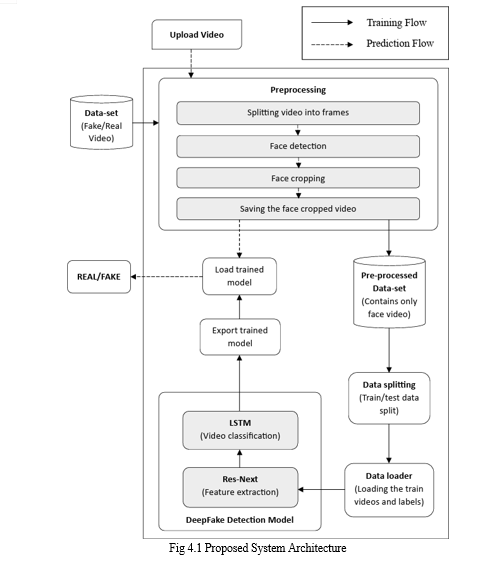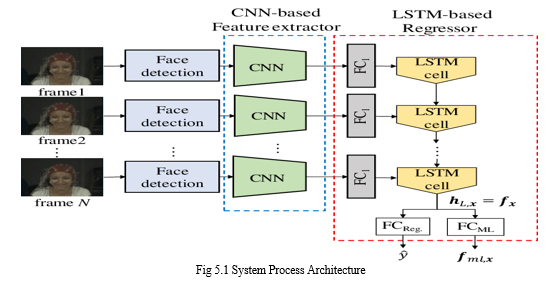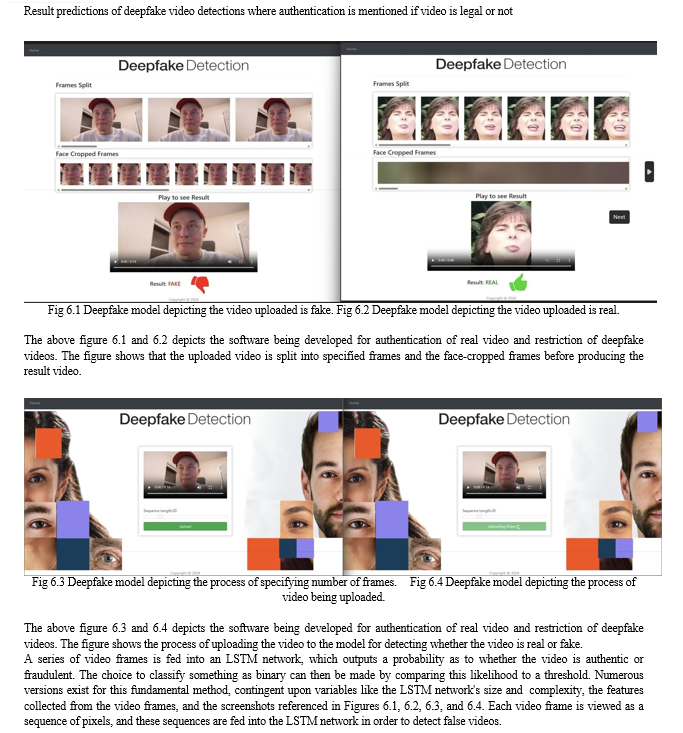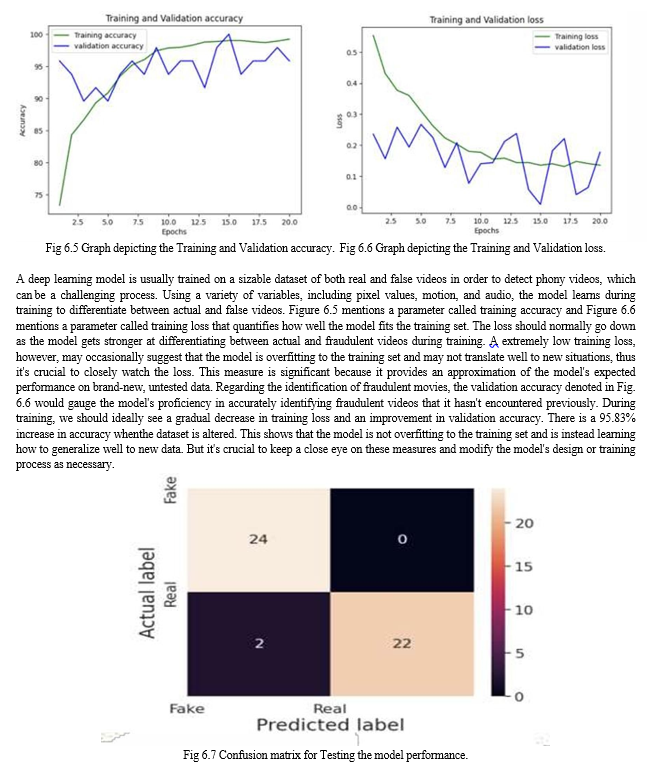Ijraset Journal For Research in Applied Science and Engineering Technology
- Home / Ijraset
- On This Page
- Abstract
- Introduction
- Conclusion
- References
- Copyright
Deepfake Video Detection Using Res-Next CNN and LSTM
Authors: Dr. Suresh M B, Likhith P, Chethan Gowda R
DOI Link: https://doi.org/10.22214/ijraset.2024.61527
Certificate: View Certificate
Abstract
Deepfake videos are becoming more and more common in the digital age, which has led to major worries about how they can undermine the trustworthiness of visual media. With deep learning algorithms\' rising processing power, producing lifelike human-synthesized films or deepfakes has never been easier. Disinformation and political unrest can be caused by these videos. A novel deep learning-based method has been created to distinguish between actual and AI-generated fraudulent videos to address this problem. The suggested technique uses Attention-based networks (Res-Next CNN), a kind of deep learning architecture that can selectively focus on significant features in a video, to fine-tune the transformer module to search for new sets of feature space to detect false images.
Introduction
I. INTRODUCTION
Deepfake films are edited videos that are produced with sophisticated machine learning and artificial intelligence techniques to produce a phony video that appears extremely realistic. We are able to effectively differentiate between pristine and deepfake videos by taking advantage of the limitations of the deepfake generation tools. The existing deep fake creation techniques leave some distinct artifacts in the frames throughout the production process that may not be evident to humans but that trained neural networks can detect. They can be used to hurt people, sway public opinion, and fabricate news. Deepfake video detection is a challenging task that can be accomplished using a variety of methods. Furthermore, the methods for producing deep fakes also progress with technology, making this a sector that is always changing and requiring new research and development. In fake video analysis, a number of machine learning methods are employed. Here are a few instances: Convolutional Neural Networks (CNNs): CNNs have been demonstrated to be successful at identifying deepfake films. CNNs are frequently utilized in image and video analysis. They are able to spot irregularities in the video's visual material, like strange facial expressions and distortions. [4] Recurrent Neural Networks (RNNs): RNNs can be used to assess the audio content of the video and are frequently employed for sequence analysis. They are able to detect irregularities in tone, pitch, and cadence in the audio. Random Forests: Random Forests are an ensemble learning algorithm that combines multiple decision trees to make a prediction. They can be used to analyse the features of the video and determine if they are consistent with a real video or a fake one.
II. BACKGROUND WORK
A. Resnext
A convolutional neural network (CNN) model called ResNeXt has been used to identify fake and morphed videos. The prominent CNN model ResNet, which has attained a contemporary performance in image recognition, is extended by ResNeXt. Utilizing the ImageNet dataset, ResNeXt outperformed ResNet [6]. The introduction of a "cardinality" parameter, which enables the network to be parallelized across many dimensions, is the primary novelty of ResNeXt. This makes it possible for the network to learn a wider range of properties, which is especially helpful for identifying deepfake movies that could differ slightly yet significantly from authentic videos.
The sequential LSTM is based on the 2048-dimensional feature vectors that follow the last pooling layers of ResNeXt. This model has 32 x 4 dimensions and 50 layers. ResNeXt has been utilized as a feature extractor in deepfake video detection in conjunction with other methods including optical flow analysis and attention mechanisms. To identify deepfake videos, ResNeXt was combined with a temporal attention module. All things considered, ResNeXt is an effective CNN model that has been used to detect deepfake videos.
B. LSTM
Recurrent neural networks (RNNs) of the LSTM (Long Short-Term Memory) type have been applied to video detection applications, such as deepfake video detection. Because LSTM can retain a memory of previous inputs and use that knowledge to influence future predictions, it is especially well-suited for processing sequential data, such as video frames. Our goal can be accomplished by employing a single LSTM layer with 2048 latent dimensions, 2048 hidden layers, and a 0.4 dropout probability. The sequential processing of the frames using LSTM allows for the comparison of the frame at 't' seconds with the frame at 't-n' seconds, which allows for the temporal analysis of the video, where n is an arbitrary number. One method for detecting deepfake videos using LSTMs is to feed the video frames into the LSTM as a series of inputs. Based on its prior inputs, the LSTM then learns to predict if each frame is authentic or fraudulent. For instance, an LSTM was used to examine the temporal dependencies in a movie and identify deepfake videos in a 2018 article by Afchar et al. [9]. Using multiple benchmark datasets, the authors demonstrated the excellent accuracy of their technique. LSTMs can also be used in conjunction with other methods, such CNNs, to aid in the detection of moving images. To identify deepfake videos, LSTM was combined with an attention mechanism and a CNN. Modern performance was attained by the LSTM approach on multiple benchmark datasets [10]. All things considered, LSTM is an effective method for identifying videos, and its capacity to record temporal dependencies makes it ideal for identifying deepfake videos. Its performance can be further enhanced by combining it with other methods like CNNs and attention processes.
III. LITERATURE SURVEY
DeepFake is a deep learning-driven video generation technology. The technique takes advantage of the spatiotemporal characteristics of movies by feeding frame sequences into the model. The method makes use of differences between several frames and lower-level properties in areas of interest. Since altered videos have the potential to have detrimental effects on a variety of industries, including politics, journalism, and entertainment, deepfake video detection is a relatively new field of study that has drawn interest.
These are the main conclusions drawn from current research on deepfake video identification. The two main strategies used by deep fake detection algorithms[13] are: 1) looking for artifacts or irregularities in the video, and 2) examining the characteristics of the person or object in the video. To increase the accuracy of deep fake detection, several academics have suggested using extra characteristics, like audio.
This is so that more evidence for detection can be obtained by analyzing the audio, which is used by some deepfake algorithms to further modify the video. The ever-evolving methods employed by those who create deep fakes present a significant obstacle to deep fake detection. To stay up to date with new developments in deep fake technology, researchers need to regularly upgrade their detection algorithms. [14] The absence of standardization in assessment metrics and datasets is another difficulty. This can impede advancement in the field and make comparing the efficacy of various detection techniques challenging. In conclusion, the discipline of deep fake video detection is quickly developing. It uses machine learning algorithms to examine video attributes and identify irregularities or artifacts that point to manipulation. Though there are still obstacles to overcome, recent studies have demonstrated encouraging outcomes in the identification of deepfake movies, and efforts are currently underway to create more potent detection techniques.
IV. PROPOSED SYSTEM
To determine the temporal dependencies between each frame and categorize whether the movies are real or fake, the proposed system uses an LSTM-based RNN to process frame-level features extracted from the videos using a Res-Next Convolution neural network. The transformer module was adjusted to use attention-based networks (Res-Next CNN) to look for new feature space sets in order to identify phony photos.
The suggested approach demonstrated good accuracy on films from many sources, demonstrating its effectiveness in real-time manipulation detection, according to the examination of the hybrid dataset. Deep fakes can be used to propagate misinformation and disrupt political processes, hence the system's capacity to identify manipulations in real time is essential. The experiment's outcomes demonstrated the effectiveness of the suggested strategy. We will give the user access to a scaled-down version of a web-based platform where they can post videos, mark them as authentic or fraudulent, and prevent them from being shared online. Large apps like Facebook, Instagram, and WhatsApp might include this idea into their software to enable simple pre- detection of distorted or fake films.

Furthermore, the deployment of such a system onto a web-based platform offers users a practical and accessible means to contribute to the detection and prevention of deepfake dissemination. By allowing users to submit videos, annotate them as authentic or fraudulent, and prevent their spread online, the platform empowers individuals to actively combat the proliferation of misinformation. Integration of this technology into popular social media platforms like Facebook, Instagram, and WhatsApp holds tremendous potential to mitigate the impact of deepfake manipulation on digital ecosystems. This proactive approach not only enhances the resilience of online communities against deceptive content but also fosters a culture of accountability and transparency in digital communication.
A. Dataset
Research on deepfake video detection has made use of a few datasets. The following are a some of the most widely used datasets: Face Forensics ++: Among the biggest and most popular deepfake video datasets is this one. It includes more than 1,000 authentic videos and more than 1,000 deepfake movies produced with a variety of techniques, such as Face2Face, Deep Fake, and Neural Textures.
Another well-liked dataset for identifying deepfake videos is Celeb-DF. It has more than 5,639 deepfake videos made with the Deep Fake technique in addition to over 890 actual footages. The Deep Fake Detection Challenge (DFDC) dataset was produced by Facebook as part of a competition to improve deepfake detection techniques.
Self-generated dataset: We have created this dataset on our own to enhance training and prediction accuracy, as well as to anticipate the detection of fraudulent video in real-time settings and optimize system performance. Usually, these datasets include tagged videos, where each one has a label designating it as authentic or fraudulent. They are frequently employed in the evaluation and training of deepfake video detection models. Nevertheless, there are drawbacks to using these datasets as well, namely the possibility of bias in the categorization procedure and the narrow range of deepfake films that are included [12]. When utilizing these datasets for deepfake video detection, researchers need to be cautious to take these constraints into account.
V. EXPERIMENT
A hybrid dataset comprising both actual and altered films from many sources was used to train and assess the suggested strategy for identifying fraudulent videos in real-time scenarios. Initially, the films were obtained from a dataset consisting of three sources [1]. DFDC [3] CELEB DF [2] FF++ Lastly, we have our own self-created dataset [4] that we employ to enhance training accuracy and produce real-time video results. Additionally, we combined the several datasets to produce a brand-new dataset. We have taken into consideration 50% real and 50% fake videos in order to prevent the model's training bias. The audio-alerted videos in the Deep Fake Detection Challenge (DFDC) dataset [3] are specific to audio alerts; audio deepfakes are not relevant to this study. After processing of the DFDC dataset, we have taken 800 Real and 500 Fake videos from the DFDC [2] dataset. 890 Real and 1400 Fake videos from the Celeb-DF [3] dataset then 310 Real and 100 fake from Self-created dataset [4]. [2] dataset. 890 Real and 1400 Fake videos from the Celeb-DF [3] dataset then 310 Real and 100 fake from Self-created dataset [4]. Which makes our total dataset consisting 3000 Real, 3000 fake videos and 6000 videos in total. Then these videos are first pre-processed in which the faces are cropped from the videos and resaved as a separate face-cropped video dataset. We took an average of 150 frames in sequence, because we consider face is an important feature to decide whether a video is fake or real. After pre-processing the face-cropped videos are saved and prepared for model training. At the first stage of training and testing the corrupted video in the face-cropped dataset are detected and removed to prevent the loss of the model. The videos are then splitted for training and testing using the metadata if the video which contains the name and label which is real or fake. Next, using PyTorch, the model is trained on the videos, and accuracy and loss are verified using a learning rate of 1-e5 and 20 epochs. Finally, the training and testing results are displayed together with a confusion matrix and graph. The trained model has been exported for prediction after training and testing. Ultimately, the user's input is processed using the loaded trained model, and the output is shown together with a confidence level and a prediction as to whether it is true or phony. . This makes their solution a useful tool for identifying and stopping the spread of deepfake content.




As seen in fig. 6.7, a confusion matrix is a table that's used to assess how well a classification model—like the false video detection model—performs. The number of true positives (TP), false positives (FP), true negatives (TN), and false negatives (FN) that the model produces is shown in the confusion matrix. Within the realm of fake video detection, a genuine video that was accurately identified as fake is called a true positive; a real video that was mistakenly identified as fake is called a false positive; a real video that was correctly identified as real is called a true negative; and a fake video that was mistakenly identified as real is called a false negative. For example, accuracy is calculated as (TP+TN)/(TP+FP+TN+FN), precision is calculated as TP/(TP+FP), recall (also known as sensitivity) is calculated as TP/(TP+FN), and F1 score is a weighted average of precision and recall. The confusion matrix and related performance measures can be examined to learn more about the advantages and disadvantages of the false video detection model. For instance, we might look into ways to strengthen the model's capacity to discern between real and fraudulent movies if it has a high false positive rate—that is, if it mistakenly labels a large number of actual videos as fake. Similarly, we could look into ways to increase the model's sensitivity to phony videos if it has a high false negative rate—that is, if it mistakenly recognizes a large number of bogus videos as real and make the model to perform as required by the users in future models for detection of deepfake videos.
Conclusion
In conclusion, the fusion of ResNet CNN and LSTM for deepfake video detection presents a promising approach with several notable outcomes. The combination of these two architectures leverages the strengths of both convolutional neural networks (CNNs) in extracting spatial features and long short-term memory (LSTM) networks in capturing temporal dependencies within video sequences. In summary, the integration of ResNet CNN and LSTM represents a significant step forward in the quest to combat deepfake manipulation. While further research and refinement are warranted, this approach holds great promise in bolstering the security and integrity of multimedia content in an era increasingly defined by digital deception.
References
[1] Agarwal, Shruti et al. “Watch Those Words: Video Falsification Detection Using Word-Conditioned Facial Motion.” 2023 IEEE/CVF Winter Conference on Applications of Computer Vision (WACV) (2021): 4699-4708. [2] N. Khatri, V. Borar, and R. Garg, “A Comparative Study: Deepfake Detection Using Deep-learning,” 2023, doi: 10.1109/Confluence56041.2023.10048888. [3] V. N. Tran, S. H. Lee, H. S. Le, B. S. Kim, and K. R. Kwon, “Learning Face Forgery Detection in Unseen Domain with Generalization Deepfake Detector,” in Digest of Technical Papers - IEEE International Conference on Consumer Electronics, 2023, vol. 2023-January, doi: 10.1109/ICCE56470.2023.10043436. [4] V. H and T. G, “Antispoofing in face biometrics: a comprehensive study on software-based techniques,” Comput. Sci. Inf. Technol., vol. 4, no. 1, 2023, doi: 10.11591/csit.v4i1.p1-13. [5] P. Gupta, C. Singh Rajpoot, and A. Professor, “A Deep Learning Technique based on Generative Adversarial Network for Heart Disease Prediction,” doi: 10.4186/ej.20xx.xx.x.xx. [6] J. Peng, M. Sun, Z. Zhang, T. Tan, and J. Yan, “Efficient neural architecture transformation search in channel-level for object detection,” in Advances in Neural Information Processing Systems, 2019, vol. 32. [7] Z. Shang, H. Xie, L. Yu, Z. Zha, and Y. Zhang, “Constructing Spatio-Temporal Graphs for Face Forgery Detection,” ACM Trans. Web, 2023, doi: 10.1145/3580512. [8] A. Maclaughlin, J. Dhamala, A. Kumar, S. Venkatapathy, R. Venkatesan, and R. Gupta, Evaluating the Effectiveness of Efficient Neural Architecture Search for Sentence-Pair Tasks. [9] A. Hesham, Y. Omar, E. El-fakharany, and R. Fatahillah, “A Proposed Model for Fake Media Detection Using Deep Learning Techniques,” in Lecture Notes on Data Engineering and Communications Technologies, vol. 152, 2023. [10] R. M. Jasim and T. S. Atia, “An evolutionary-convolutional neural network for fake image detection,” Indones. J. Electr. Eng. Comput. Sci., vol. 29, no. 3, 2023, doi: 10.11591/ijeecs.v29.i3.pp1657-1667. [11] P. Pei, X. Zhao, Y. Cao, and C. Hu, “Visual Explanations for Exposing Potential Inconsistency of Deepfakes,” in Lecture Notes in Computer Science (including subseries Lecture Notes in Artificial Intelligence and Lecture Notes in Bioinformatics), 2023, vol. 13825 LNCS, doi: 10.1007/978-3-031-25115-3_5. [12] C. B. Miller, “Technology and the Virtue of Honesty,” in Technology Ethics: A Philosophical Introduction and Readings, 2023. [13] W. Lu et al., “Detection of Deepfake Videos Using Long-Distance Attention,” IEEE Trans. Neural Networks Learn. Syst., 2023, doi: 10.1109/tnnls.2022.3233063. [14] Q. Xu, H. Qiao, S. Liu, and S. Liu, “Deepfake detection based on remote photoplethysmography,” Multimed. Tools Appl. 2023, doi:10.1007/s11042-023-14744- z. [15] Y. Patel et al., “An Improved Dense CNN Architecture for Deepfake Image Detection,” IEEE Access, 2023, doi: 10.1109/ACCESS.2023.325141.
Copyright
Copyright © 2024 Dr. Suresh M B, Likhith P, Chethan Gowda R. This is an open access article distributed under the Creative Commons Attribution License, which permits unrestricted use, distribution, and reproduction in any medium, provided the original work is properly cited.

Download Paper
Paper Id : IJRASET61527
Publish Date : 2024-05-03
ISSN : 2321-9653
Publisher Name : IJRASET
DOI Link : Click Here
 Submit Paper Online
Submit Paper Online

